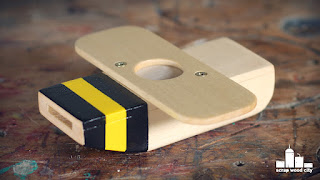I really want to thank SKIL for sending me many power tools which I use every day:
Tools and materials I propose:
Making your own training equipment is really fun. I made two dip bars out of reclaimed pine and a 40mm spruce dowel.
I begun by glueing three boards together for each leg. I used another board as a spacer. I used nails to secure the pieces in place while the glue dried out.
I then cut all the pieces to length on the table saw. A circular saw and a speed square works just as well.
I then made a quick jig so I can easily mark the dowel’s position on each leg. This also helped me to avoid measuring. I then used a 38mm spade bit to drill the hole for the dowel. To avoid tear out I drilled the hole from both ends.
I then rounded over the bases of the legs on my belt sander. You can also use a saw and a sanding block.
My dowel was 40mm and my largest spade bit was 38mm. So I came up with a smart set up, so I can reduce the size of the dowel’s ends on the table saw. You can also go old school and use a saw, a chisel and a file to do that job.
At this point I sanded all the parts. I also broke the edges with my block plane.
I added screws on the legs for extra strength. I first predrilled pilot holes and I counter sinked them.
I then glued and screwed the bases in place.
To make sure that the legs are perpendicular to the dowel I made a spacer to help me glue the dowel straight.
I then glued and screwed two braces close to the bases, to keep everything nice and strong.
Finally I cut the dowels flush with a saw. I used a piece of masking tape to prevent the saw blade from damaging the wood.
My dip bars came out great. Now it’s time to do some chest exercises. But I hope you liked this one, because that was it. See you soon with a new project video.
Disclosure: Some of the links below are affiliate links, meaning, that at no cost to you, I get a small commission if you click through and make a purchase.





























